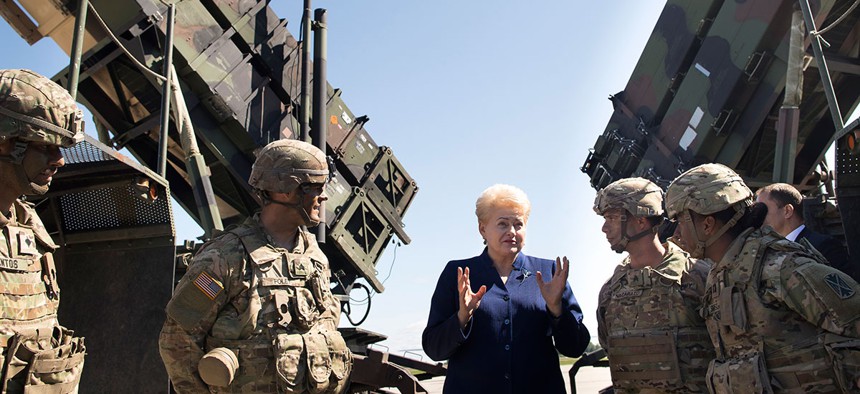
Would Lithuania's president be so pumped if she knew the Patriot's record? Mindaugas Kulbis/AP
The Patriot Missile Interceptor Doesn’t Work, But Raytheon Still Makes Billions
Have the U.S. and its allies spent bought a lemon?
The U.S. and its allies the world over are paying billions for medium-range missile interception systems without a track record of success.
A March 25 missile attack launched on Saudi Arabia by Iranian-backed Houthi rebels in Yemen provided another test of the U.S.-built Patriot missile system, which it apparently failed—cell phone video shows an interceptor suddenly turning and exploding in a Riyadh neighborhood.
Days later, Poland signed a $4.75 billion deal to purchase the Patriot missile system.
The Defense Department has awarded its manufacturer, Raytheon, $3.8 billion in Patriot-related contracts in just the last year. Government auditors say taxpayers have spent more than $6.5 billion since 2004 on the latest iteration of the system. The company’s missile-interceptor division boasts a profit margin of more than 16%, according to industry analysts.
“We do not comment on the operational use of our products,” a Raytheon spokesperson said in an e-mailed statement. “We refer you to Saudi authorities. We don’t disclose individual product financials.”
Raytheon’s website says the system has shot down 100 missiles in combat, but the company declined to supply additional detail.
The mobile Patriot system—which includes advanced radar to detect incoming missiles, and a launcher for the rocket-powered interceptors designed to destroy them—has been sold to numerous US allies, including Germany, Bahrain, South Korea, Kuwait, Qatar, the United Arab Emirates, Taiwan, the Netherlands, Saudi Arabia, and Romania. (The US Missile Defense Agency, the Defense Department unit charged with combatting ballistic missiles, did not respond to requests for comment by time of publication.)
The Patriot system’s track record has long been called into question. Jeffrey Lewis, an arms-control expert, says he is skeptical that it has ever intercepted a long-range missile in combat operations. Among other evidence, he cites congressional investigators who found that missile’s debut during the Gulf War was likely unsuccessful, with less than 9% of launches resulting in interception.
“The public and the Congress were misled by definitive statements of success issued by administration and Raytheon representatives during and after the war,” a summary of their report concludes.
When I called the Saudi Embassy in Washington for comment on the most recent missile attack, I was transferred to a full voice mailbox. Saudi defense officials have told reporters that all seven of the Houthi missiles were successfully intercepted; they said the same about supposed interceptions in 2017 that Lewis and his colleagues convincingly debunked.
The likely failure of the interceptors is tied to the wave of incoming missiles: Multiple targets can confuse or overwhelm the radar systems designed to track them. Even in perfect conditions, missile defense is tricky business: When the explosive warhead separates from the Burkan-2 missile used by Houthi rebels, it is perhaps two meters tall and less than a meter in diameter, moving more than two kilometers per second. Interceptors have about nine minutes to detect and destroy the warheads between launch and impact.
“Patriot misses most of the time (or even all of the time) for the same reason that hitting .300 (thirty percent!) is considered excellent—it’s hard to hit the nasty stuff they throw in the big leagues. Same thing with long-range missiles,” Lewis wrote Quartz in an e-mail.
There is a case that misrepresenting the capability of these systems offers a deterrent effect on its own, reducing attempts to launch missiles against supposedly protected targets. But the assumption of high-quality of missile defenses can lead policymakers to act as if rhetoric matches reality. This is equally and more frighteningly true of similarly dubious systems designed to stop nuclear missiles targeting the US from across the ocean.







